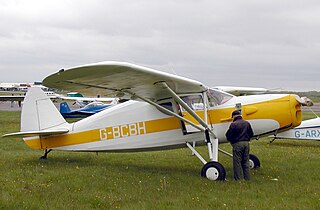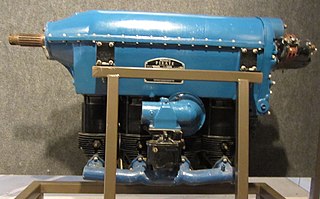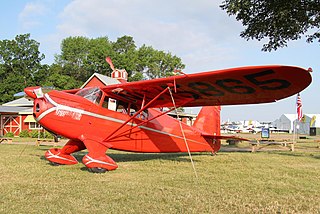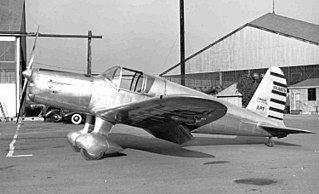
The Fairchild Model 24, also called the Fairchild Model 24 Argus and UC-61 Forwarder, is a four-seat, single-engine monoplane light transport aircraft designed by the Fairchild Aviation Corporation in the 1930s. It was adopted by the United States Army Air Corps as UC-61 and also by the Royal Air Force. The Model 24 was itself a development of previous Fairchild models and became a successful civil and military utility aircraft.

The Ryan STs were a series of two seat, low-wing monoplane aircraft built in the United States by the Ryan Aeronautical Company. They were used as sport aircraft, as well as trainers by flying schools and the militaries of several countries.

The Lockheed Altair was a single-engined sport aircraft produced by Lockheed Aircraft Limited in the 1930s. It was a development of the Lockheed Sirius with a retractable undercarriage, and was the first Lockheed aircraft and one of the first aircraft designs with a fully retractable undercarriage.

The Warner Scarab is an American seven-cylinder radial aircraft engine, that was manufactured by the Warner Aircraft Corporation of Detroit, Michigan in 1928 through to the early 1940s. In military service the engine was designated R-420.

The Culver Dart was a 1930s American two-seat light monoplane aircraft produced by the Dart Aircraft Company.

The Menasco Pirate series were four-cylinder, air-cooled, in-line, inverted aero-engines, built by the Menasco Motors Company of Burbank, California, for use in light general and sport aircraft during the 1930s and 1940s. The Menasco engines came in both normally aspirated and supercharged forms, with the supercharged models exhibiting superior performance at higher altitudes, with a relatively small increase in dimensions and weight. The supercharged models had the S suffix added to their designation to show supercharging.

The Kreider-Reisner Challenger was an American utility biplane aircraft designed and produced by the Kreider-Reisner Aircraft Company, which was later taken over by the Fairchild Aircraft Company.

The Fairchild 22 Model C7 was an American two-seat touring or training monoplane designed and built by the Kreider-Reisner division of the Fairchild Aircraft Corporation at Hagerstown, Maryland.

The Great Lakes Sport Trainer is an American biplane trainer and aerobatic aircraft. It was originally produced in large numbers before the company building it went bankrupt in the Great Depression in 1933. Owing to its continuing popularity, however, it was eventually placed back into production in the 1970s and again in 2011 by WACO Classic Aircraft.

The Gee Bee Model Y Senior Sportster was a sport aircraft built in the United States in the early 1930s by the Granville Brothers. Essentially an enlarged two-seat version of the single-seat Sportster, it was a low-wing strut-and-wire-braced monoplane of conventional design with open cockpits and fixed tailskid undercarriage. The first of the two examples constructed remained with the Granville Brothers company and competed in many races, piloted by Maude Tait and Russell Boardman, among others. Later it also served as a support aircraft for the R-1 and R-2 racers. The second Model Y was built to order for the Cord Auto Company to be used as an engine testbed for the Lycoming R-680 engine they produced. This aircraft was later refitted with a Wright Whirlwind of nearly double the power of its original powerplant. In this form, it was flown by Florence Klingensmith at the 1933 Chicago International Races, where she won second place in the Women's Free-For-All, then perished in the aircraft after fabric became detached from the upper right wing while contesting the Phillips Trophy.
Lowell Richard Bayles was an air race pilot from the "Golden Age of Air Racing." He was the winner of the 1931 Thompson Trophy flying the Gee Bee Model Z. He was killed during an attempt at the landplane speed record when the Model Z he was flying crashed at over 300 miles per hour (483 km/h) mph.

The Rearwin Sportster is a 1930s American two-seat, high-winged, cabin monoplane designed and built by Rearwin Aircraft & Engines for sport/touring use.

The Rearwin Speedster was a two-seat, high-wing, sport aircraft produced by Rearwin Airplanes Inc. in the United States in the 1930s.

The Granville Gee Bee Model Z was an American racing aircraft of the early 1930s, the first of the Super Sportster aircraft built by Granville Brothers Aircraft of Springfield, Massachusetts, with the sole intent of winning the Thompson Trophy, which it did in 1931. However, it soon suffered a fatal crash during a world speed record attempt, starting the reputation of the Gee Bee aircraft as killers.

The Granville Gee Bee R-6 International Super Sportster, named "Q.E.D.", and later named "Conquistador del Cielo", was the last in a series of racing and touring monoplane aircraft from the Granville Brothers. The R-6H was dogged with bad luck throughout its career and never finished any race it entered.

The Aeronca K series, Aeronca Chief, Aeronca Super Chief, Aeronca Tandem, Aeronca Scout, Aeronca Sea Scout, Aeronca Champion and Aeronca Defender were a family of American high-winged light touring aircraft, designed and built starting in the late 1930s by Aeronca Aircraft.

The Tachihi R-53 was amongst the first aircraft built in Japan after the relaxation of the ban imposed at the end of World War II. It is a parasol-wing, two seat, training aircraft powered by a British engine. Only one was produced.

The Aeroneer 1-B is an all-metal light aircraft built in the United States in 1936. It did not reach production, despite an attempt to interest the USAAC in it as a trainer, but it appeared in three Hollywood films.
The LKL IV and LKL V were a pair of very similar Polish parasol wing two-seaters, built in the early 1930s. They differed primarily in their engines.

The Gee Bee Model A was an American two-seat open cockpit single-bay biplane developed by the Granville Brothers that first flew in 1929.



















